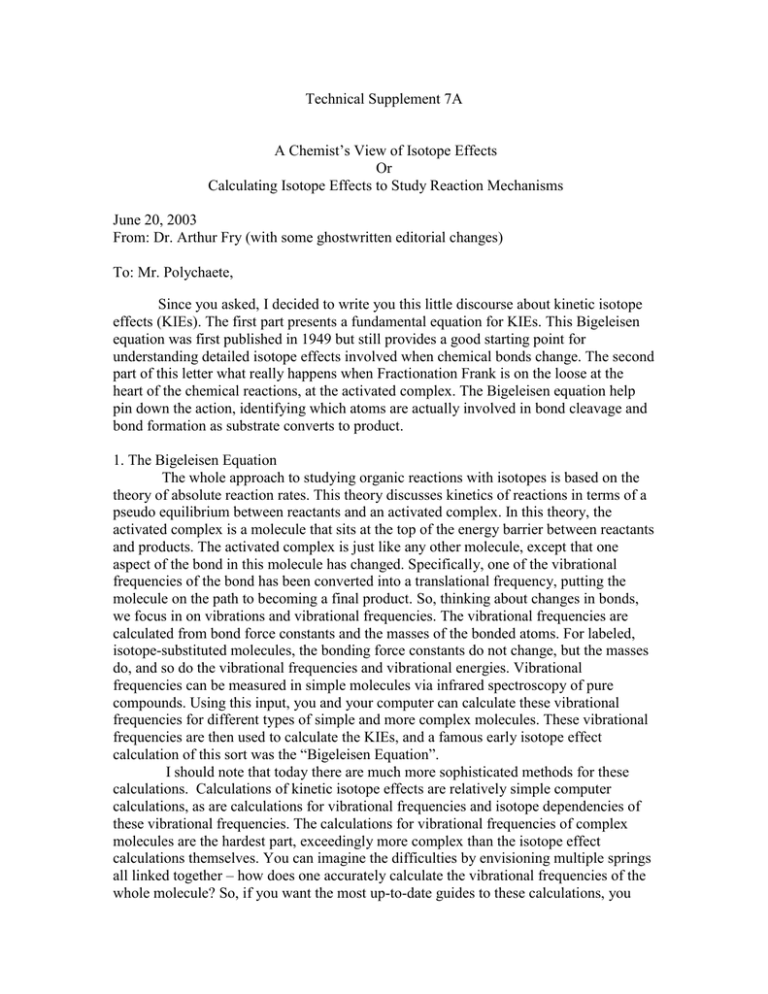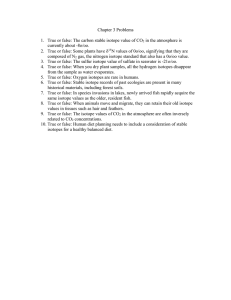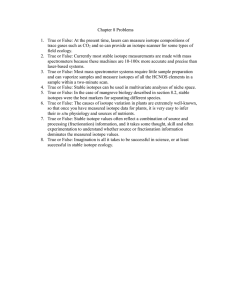Technical Supplement 7A.doc
advertisement

Technical Supplement 7A A Chemist’s View of Isotope Effects Or Calculating Isotope Effects to Study Reaction Mechanisms June 20, 2003 From: Dr. Arthur Fry (with some ghostwritten editorial changes) To: Mr. Polychaete, Since you asked, I decided to write you this little discourse about kinetic isotope effects (KIEs). The first part presents a fundamental equation for KIEs. This Bigeleisen equation was first published in 1949 but still provides a good starting point for understanding detailed isotope effects involved when chemical bonds change. The second part of this letter what really happens when Fractionation Frank is on the loose at the heart of the chemical reactions, at the activated complex. The Bigeleisen equation help pin down the action, identifying which atoms are actually involved in bond cleavage and bond formation as substrate converts to product. 1. The Bigeleisen Equation The whole approach to studying organic reactions with isotopes is based on the theory of absolute reaction rates. This theory discusses kinetics of reactions in terms of a pseudo equilibrium between reactants and an activated complex. In this theory, the activated complex is a molecule that sits at the top of the energy barrier between reactants and products. The activated complex is just like any other molecule, except that one aspect of the bond in this molecule has changed. Specifically, one of the vibrational frequencies of the bond has been converted into a translational frequency, putting the molecule on the path to becoming a final product. So, thinking about changes in bonds, we focus in on vibrations and vibrational frequencies. The vibrational frequencies are calculated from bond force constants and the masses of the bonded atoms. For labeled, isotope-substituted molecules, the bonding force constants do not change, but the masses do, and so do the vibrational frequencies and vibrational energies. Vibrational frequencies can be measured in simple molecules via infrared spectroscopy of pure compounds. Using this input, you and your computer can calculate these vibrational frequencies for different types of simple and more complex molecules. These vibrational frequencies are then used to calculate the KIEs, and a famous early isotope effect calculation of this sort was the “Bigeleisen Equation”. I should note that today there are much more sophisticated methods for these calculations. Calculations of kinetic isotope effects are relatively simple computer calculations, as are calculations for vibrational frequencies and isotope dependencies of these vibrational frequencies. The calculations for vibrational frequencies of complex molecules are the hardest part, exceedingly more complex than the isotope effect calculations themselves. You can imagine the difficulties by envisioning multiple springs all linked together – how does one accurately calculate the vibrational frequencies of the whole molecule? So, if you want the most up-to-date guides to these calculations, you should probably consult the internet. That said, let’s look at the “easy” part of the old basic calculations. The version of the Bigeleisen equation I will use is this one: k1/k2 = (1L‡/2L‡) [1 + in G(ui)ui - in G(ui‡)ui‡] terms: 1) k1 and k2 are the kinetic reaction rates for molecules containing the light isotope and the heavy isotope, respectively, with the lighter isotope expected to react faster so that k1 > k2 and k1/k2 >1, 2) 1‡ and 2‡ are reaction coordinate terms that apply to the activated complex through which molecules pass as bonds are broken or formed, with 1 and 2 referring to the light and heavy isotopes, respectively. The "" is actually the pseudo vibrational frequency along the reaction coordinate - the path that leads from reactions to products. The "" is a vibrational frequency that “goes missing” if a bond breaks, and is "partially there", sort of, if a bond forms. The “L” subscripts are often omitted, but also reflect progress of the reaction. 3) The first term inside the brackets is unity – the second and third add to or subtract from it. The second term inside the brackets refers to the reactants, and the third term (carrying the double dagger symbol, ‡) refers to the activated complex. G(ui) is a an energy term from quantum mechanics and combines the numerical function (G) and the energy value of the “i”th vibrational bond frequency ui. ui is the difference in vibrational energies of a bond for the light and heavy isotopes, with vibrational frequencies being the measured variables used to estimate the vibrational energies, 5) G(ui‡)ui‡, as definitions 3) and 4) above, but this time for the activated complex denoted by (‡). 6) Concerning the summation terms inside the brackets in the above equation, the following gives more detail than you might want to know. The summation term refers to summing over all the vibrational states. Summation is based on realizing that every molecule that contains n atoms has 3n degrees of freedom corresponding to three kinds of bond energies, the rotational, translational and vibrational energies. (With the exception of the hydrogen isotope calculations where translational effects are important (and where isotopes sometimes cheat and “tunnel” through energy barriers using their magic quantum powers, rather than bothering to go up and over the energy hill), the isotope effect calculations focus only on the vibrational energies, but for completeness, all the energy states are included in the Bigeleisen equation). That said, three of the n are rotations, and 3 are translations. All the rest are vibrations, so there are 3n-6 vibrations (except for linear molecules for which there are only two rotational degrees of freedom, resulting in 3n-5 vibrations instead of 3n-6). For the activated complex, the number for vibrations is 3n-7, with the missing vibration assigned to the developing action in the breaking or formation of the bond. The activated complex has only 3n-7 real vibrational frequencies, not the usual 3n-6, because the "vibration along the reaction coordinate" is not there anymore. So, in the end, the upshot of all this is that when there is an isotope dependent effect in the reaction, the first summation in the brackets will be larger than the second summation, because there are fewer vibrational energy terms in the second summation where one of the vibrational frequencies is changed into a translational frequency. Summarizing to this point, the focus is on two basic parts to the Bigeleisen equation, the part concerning the substrate and the part concerning the activated complex (or product in equilibrium calculations). Comparison of energies in the substrate vs. activated complex gives the predicted isotope effect, and the approach is based on a quantum mechanical view of reactions, with reaction rates derived from various “partition functions”, the summation terms above. The calculation is especially based on differences in vibrational energies of bonds. The vibrational energies are the prominent energies differing between bonds with light and heavy isotopes, at least for the heavier, non-hydrogen elements. Let’s conclude this presentation of the Bigeleisen equation with a few last notes about certain terms. First, there is a "reaction coordinate" term (1L‡/2L‡) in front of the bracketed term. This is often taken as the “reduced mass ratio” of, for example, a 12 C-to-12C bond vs. a 12C-to-13C bond in a simple bond breaking process = Square root of [(12*13/25)*(12*12/24)] = 1.0198. The “reduced mass” calculation comes from the physics of springs that vibrate (like slinkies), or “simple harmonic oscillators” (or “SHO”s; Criss 1999). We chemists borrowed this nifty equation from the physicists. For other cases, the “reaction coordinate” involves an estimate for the isotope dependence of the vibration in the reactant that becomes a translation in the activated complex. Evaluation of this term was always one of the weak spots in the move from "qualitative" to "semi-quantitative" in using the Bigeleisen equation. Bigeleisen has always claimed that this term is always greater than one, regardless of the nature of the reaction--I've always had some reservations about that for bond formation cases, but I've generally accepted it. Inside the brackets, you add to unity, a summation partition function term (containing 3n-6 vibrational frequencies; the first G term) for the reactions and subtract a similar summation partition function term for the activated complex (the second G term containing 3n-7 vibrational frequencies, with the missing one being the one that becomes the translation). Note that the G(u) terms are the vibrational frequencies expressed in energy terms, and the u terms are the isotope shifts (energy terms) for each of those frequencies. 2. Applications to Studies of Reactions Mechanisms With a general understanding of the Bigeleisen equation developed above, now let’s consider how this complex equation can be applied to a fundamental problem facing organic chemists, specifically what is the structure of the activated complex in reactions. One can deduce this hard-to-observe activated complex by KIE studies as follows. First consider the vibrations of a complex molecule, the G(u) terms in the Bigeleisen equation above, and the isotope dependence of each of them = the u terms. If there is no labeling, all u terms are zero, so the term in brackets is just unity (and the term in front of the brackets is also unity (no labeling, so no "labeling effect") so the ratio of rate constants is unity by definition. Now, put a label somewhere in the molecule. Each of the vibrations of the molecule includes every atom in the molecule, but an excellent first approximation is that all vibrations involve mainly a single bond with minor effects extending to nearby bonds, and practically negligible effects on more distant bonds. ("Secondary" isotope effect arise from these more distant effects, and are important only with deuterium and tritium studies. Here think in terms of a bunch of interconnected springs. That is, stretch one, and the whole molecule wiggles, but the wiggle is most where you stretched it). Now consider two cases. (1) If the label is at a position in the molecule where "nothing is happening" in the reaction (mechanism) as reactants form from products, one of the vibrational frequencies in the first sumation term will be missing in the second G term, so there is no contribution from the second G term. For that particular frequency, u = 0 (by definition--it is missing), so it contributes nothing to the sum, neither positive nor negative. For that specific frequency in the first G term, by definition, u = 0, so "its term" makes no contribution to the first G term either. All the other 3n-7 frequencies in the first summation term will have positive contributions, but for each of them there will be a corresponding IDENTICAL negative term from the second summation, so the term in brackets is also unity. "Nothing is happening" at a labeled position (by definition) so the term in front of the brackets for the one vibrational frequency that becomes a translation is also unity, and there is no isotope effect and the rate constant ratio = unity. (2) If the label is at the position in the molecule where the reaction is "happening", that frequency will have a u and a u term in the first G term, but it is "gone" (u = 0) (by definition) in the second G term. It has become a translation and is "handled" by the term in front of the brackets. But all the other 3n-7 vibrations have positive G(u)u terms in the first G term are exactly matched by negative G(u)u terms in the second G term. Therefore the term in the brackets will be unity plus (just) one, positive summation G(u)u term, so that in the end, the rate constant will be greater than unity. Notes: 1) All G(u)u terms are, by their nature, positive, and 2) there are complications on this point in intramolecular cases, which I have studied a lot but will not go into. Now, having waded through these mechanics, let’s think about an example where you wanted to study not the reactants or the products, but the transition complex which is very evanescent and hard to observe by any known means, except via isotopes. If you apply the steps outlined in the above paragraph to the same molecule but now labeled in a different position, then you will have a kinetic isotope effect when and only when there are bonding changes in going from reactants to the activated complexes. By switching the position of the label around in a molecule (chemists do this for fun and fame, to show they are worth their salt as organic chemists), you can successively identify all the atomic positions in a molecule which undergo bonding changes in going from reactants to activated complexes by whether or not (qualitative argument only needed) isotope effects are observed with the molecule labeled at each of those positions. In principle, also one can derive all of the structural features of the reaction's activated complex by focusing on the magnitudes of isotope effects, and on the comparisons of observed and calculated isotope effects for different reactant and activated complex models. As it turns out, it is often fairly easy to match experiment and calculation for more than one model for a molecule labeled at only one position. But if you label the molecule successively at several different positions, the number of models that match experiment and calculation decreases drastically. Ideally, with enough data there should be only one acceptable model, the correct one. So, you unravel nature’s secrets with isotopes, the most intimate reaction mechanisms via the “successive labeling” technique. I have no idea about whether this will be of any help to you, but it was fun to "go back over it again". Love, Dad P.S. You should consult some of the references below for more details; especially the Bigeleisen and Wolfsberg review paper gives derivations and a calculated example – pay special attention therein to equation II.21 and pp. 65-73. Further Reading Anderson, T.F. and M.A. Arthur. 1983. Stable isotopes of oxygen and carbon and their application to sedimentologic and paleaoenvironmental problems, pp. 1-1 – 1-151. In: Arthur, M.A., T.F. Anderson, I.R. Kaplan, J. Veizer, and L.S. Land (eds). 1983. Stable Isotopes in Sedimentary Geology. SEPM Short Course #10, Dallas. Society of Economic Paleontologists and Mineralogists. Bigeleisen, J. 1949. The validity of the use of tracers to follow chemical reactions. Science 110:14-16. Bigeleisen, J. 1949. The relative reaction velocities of isotopic molecules. Journal of Chemical Physics 17:675-678. Bigeleisen, J. and M.G. Mayer. 1947. Calculation of equilibrium constants for isotopic exchange reactions. Journal of Chemical Physics 15:261-267. Bigeleisen, J. and M. Wolfsberg. 1958. Theoretical and experimental aspects of isotope effects in chemical reactions, pp. 15-76. In: I. Prigogine, Advances in Chemical Physics, v. 1. Criss, R.E. 1999. Principles of Stable Isotope Distribution. Oxford University Press. Fry, A. 1964. Application of the successive labeling technique to some carbon, nitrogen and chlorine isotope effect studies of organic reaction mechanisms. Pure and Applied Chemistry 8:409-419. Hasan, T., L.B. Sims and A. Fry. 1983. Heavy atom isotope effect studies of elimination reaction mechanisms. 1. A kinetic and carbon-14 kinetic isotope effect study of the basepromoted dehydrochlorination of substituted 1-phenylethyl-2-14C chlorides. Journal of the American Chemical Society 105: 3967-3975. Sims, L.B., A. Fry, D.E. Lewis, and L.T. Netherton. 1983. Interplay of experiment and theory in isotope effect research, pp. 261-266. In W.P. Duncan and A.B Susan (eds), Synthesis and Applications of Isotopically Labeled Compounds, Proceedings of an International Symposium. Elsevier. Urey, H.C. 1947. The thermodynamic properties of isotopic substances. Journal of the Chemical Society (London), Part 1:562-581.





